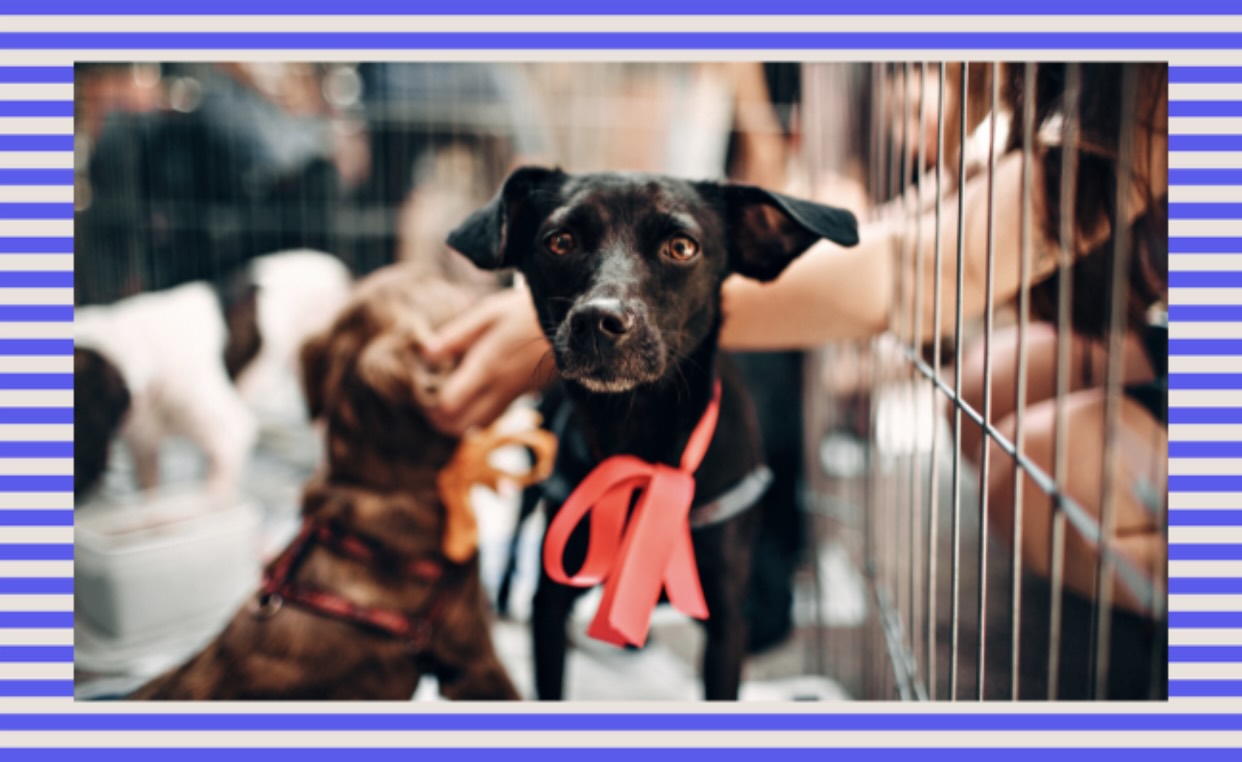The year we got married, my partner and I fostered five dogs from our local shelter. First we spent two months with Val, a bully breed mix recovering from a broken leg. Then we met Arlo and Mystic, boisterous littermates who stole our sleep but also our hearts. In the fall we cared for Joey and Ross, two of the sickest puppies I’d met before they recovered into delightful monsters of chaos. Finally, Mystic found herself back at the shelter after her first adoption fell through, and we took her in again. It was a bittersweet joy to meet the adolescent she’d grown into.
Thanks to volunteers like @simonsits, @bully.baloo, and @themobtrio taking to social media to share their own stories, more and more pet parents are expressing interest in becoming foster parents themselves. (We love to see it!) Nearly six million dogs and cats enter the United States shelter system each year, and according to the ASPCA, many rescue organizations face an ongoing capacity crisis due to “more animals staying longer in shelters, as well as an increasing proportion of animals with greater medical and behavioral needs.” Foster homes make a huge difference by freeing up shelter space and giving potential adopters the chance to learn more about an available dog’s behavior in a home environment.
Fostering was one of the most rewarding experiences I’ve had as an animal lover. (I can’t wait to do it again.) It was also one of the most challenging—and that’s okay to admit, too.
If you’re wondering if you’re ready to open up your home to a shelter dog, we’ve got your back through all the decision’s details. Let’s take a look at financial, lifestyle, and emotional logistics to decide if fostering is right for you. (And if it isn’t? Don’t worry. There are dozens of other ways you can help the homeless pet crisis! We’ll get into those, too.

Finances: What does it cost to foster a dog?
Good news first: Most of the time it costs very little to foster a dog! Shelters and rescues generally provide foster homes with basic supplies (like a leash, food, and crate). They also cover medical fees, which means you don’t need to drain your own bank account to help an animal in need.
The one thing to be prepared for is emergency expenses. Even if these costs are reimbursed, they can put immediate strain on your own finances in the meantime—especially if your foster dog experiences a sudden accident or medical emergency.
Existing pets: Can you foster with other animals in your home?
People are sometimes surprised when I talk about our foster dog experiences. It’s no secret that our resident heeler, Scout, is a sensitive shelter rescue herself. After years of fear reactivity training, she still doesn’t want to play with other dogs—let alone welcome them into her own home.
We made fostering work not only because we wanted to but mostly because we were able to. We were fortunate to live in a house with multiple rooms, separate entrances, and a fenced yard that allowed us to give each dog their own space to decompress without forcing interactions. If we’d been in a studio apartment or tighter situation? Scout would have said “no thanks” to being a foster sister—and we would have found other ways to support our local shelter.
The logistics of separating foster and resident dogs
For context, here are some things we had to think about whenever we had a foster dog:
- Is every dog getting enough exercise, enrichment, and social time with us? At first I underestimated the time commitment of doing everything separately. On occasion, my partner and I even slept apart—one of us in the guest room with our foster and the other in our own room with Scout—to make sure everyone got adequate rest.
- How are we keeping the dogs separate? Depending on the pup’s personalities and our capacity to supervise, we used everything from rooms on opposite ends of the house to tethers in the same space.
- Is our foster’s presence stressing out our own dog or vice versa? Some stress is totally normal when integrating any new creature into your home—but it was important to me that we didn’t push Scout too far or put our fosters in an unwelcoming environment.
Some foster dogs integrate easily
Fostering will be simplest if your resident pets enjoy being around other dogs and your foster pup is social, too. You’re also a great candidate if you don’t have animals of your own right now but are overflowing with love to give. (That’s the dream foster situation for rescue dogs who might benefit from being the only animal as they adjust!)
Know that there are no wrong answers here as long as you think the decision through. Fostering with a non-social resident dog was worth it for us—but I won’t pretend it was easy. What matters most is that everyone feels safe and comfortable. You know your dog best!

What’s a Rich Text element?
The rich text element allows you to create and format headings, paragraphs, blockquotes, images, and video all in one place instead of having to add and format them individually. Just double-click and easily create content.

Static and dynamic content editing
Static and dynamic content editing
A rich text element can be used with static or dynamic content. For static content, just drop it into any page and begin editing. For dynamic content, add a rich text field to any collection and then connect a rich text element to that field in the settings panel. Voila!
How to customize formatting for each rich text
Headings, paragraphs, blockquotes, figures, images, and figure captions can all be styled after a class is added to the rich text element using the "When inside of" nested selector system.
Lifestyle: Is your home right for a foster dog?
Dogs don’t need huge yards or massive houses to be happy. (Anecdotally, our heeler’s favorite place she’s ever lived is our tiny converted van.) That said, certain lifestyles do lend themselves better to caring for a foster pup—especially if you take in a dog whose past and preferences aren’t fully understood yet.
Questions to ask before bringing home a foster dog
- Does your home environment allow you to set up a quiet space where your foster dog can decompress?
- Are you able to access a safe area for your foster dog to use the bathroom?
- How will you exercise and provide enrichment for your foster dog?
- Do you have a support network? Some incredible fosterers do it all on their own—but going solo takes more time and effort. If you aren’t sure you’re ready for a foster commitment, having a partner or friend on board can make a world of difference.
- Do you have young kids? Fostering can be an incredible experience for the entire family! But know that some dogs feel nervous around fast movement and loud noises. Shelter staff can help you find the right fit, and a little planning ahead can go a long way. (Pro tip: Establish an area, like a crate or small room, that is “dogs only” so your foster can take time to themself when they need it.)

Schedules: How much time does it take to foster a dog?
Like everything in dog parenting, the answer is “it depends.” Some people foster entire litters of puppies who need round-the-clock care. Others foster relaxed, middle-aged dogs who want a simple walk and occasional belly rub. Each situation is different!
Think about how long you’d be able to open your home to a foster dog. Most of the time shelters and rescues prefer that you can commit to caring for a pup until they get adopted—but many organizations also offer short-stay programs (like weekend pet sitting for other foster homes) that work with busier schedules. While you’re at it, consider how many hours you’d realistically be able to devote to your foster each day.
We should always be prepared for surprises when living with animals—there are no guarantees about an individual dog’s preferences and needs—but shelter staff often can make educated guesses about what certain dogs need to thrive in a foster home.
Some foster dogs require constant care
My partner and I were able to take on puppies (who needed frequent bathroom breaks in the potty training process) and medical cases (who had to be supervised and given medication at exact times) in large part because I worked from home on a flexible schedule.
Some foster dogs are chill and easy
If you’re running around with a full-time job and laundry list of other obligations? High need fosters might not be the right choice for you—but a more chill companion could be perfect!
Many dogs in the shelter system are healthy, well adjusted, and simply looking for a new place to land through no fault of their own. In these cases, the ideal foster home is able to let them out for routine bathroom breaks, provide regular meals, and spend some quality time together. (Remember: It doesn’t take much to provide a pup with a better environment than sitting in a shelter.)
Emotions: Can you let a foster dog go?
“But how do you let them go?” is one of the most common questions people asked about our foster dogs. I get it. People want foster homes to turn into forever homes! But even though “foster failing” can be a great way to get your next dog, it isn’t always the right choice.
Make no mistake: It’s difficult to say goodbye to a dog you’ve fallen in love with. At the same time, though? It’s easy when you know they’re going to a wonderful home—and when you realize that letting them go will enable you to let a new one in.
With the right support from your local shelter or rescue, the emotional rollercoaster of fostering is more manageable than you might think. And as we become increasingly connected via the digital world, staying up-to-date on past fosters is more common than ever. I treasure the photos and videos adopters have sent me!
Fostering a dog might not be right for you if…
- Your existing schedule demands the bulk of your time.
- Your own pets aren’t comfortable with other animals in their home.
- You’re still working on your resident dogs’ training and aren’t sure they’re ready to share their space.
- You aren’t in a position to provide a shelter pup with a calm, consistent environment right now.
You might be in the perfect position to foster a dog if…
- You work remotely, have a flexible schedule, or can count on being home at a regular time each day.
- There’s room in your schedule to meet the needs of all the animals in your care.
- Your own pets enjoy the company of other dogs, or you have enough space and to keep your foster dog separated if necessary.
- You want to help pups get out of the shelter system!

Other ways to make a difference
We had to stop fostering when we moved into our converted campervan in 2023—but that doesn’t mean we stopped supporting animal rescue. Don’t worry if hosting a shelter dog in your own home isn’t the best option for you right now. (Fostering is never a decision you should make under pressure.) There are still so many ways you can help the homeless pet crisis!
Raise awareness for rescue dogs
This is something everybody can do. Try promoting adoptable pets to your in-person and online networks. Share adoption profiles. Offer to help friends who are looking for a new dog find their best match at a local rescue!
Volunteer at your local shelter
Volunteering can take many forms! Consider signing up to:
- Walk and play with shelter dogs
- Clean kennels and communal spaces
- Participate in or pilot your own shelter dog enrichment program (see how Taylor Finton, face behind @bindisbucketlist and author of The Happiest Dog on the Block, has done this at her own local shelter)
- Lend your technical skills in other areas like marketing, social media, event planning, and more.
Fundraise for rescue organizations
You can also fundraise at community events. Some small business owners and hobbyists create and sell custom merchandise to promote shelter pets, then donate the proceeds back to the organizations in need.
Donate money and supplies
If you’re short on time but do have some dispensable income? Shelters and rescues are constantly in need of donations to keep their operations running. You can sponsor a specific animal’s adoption fee, contribute to a general fund, or get in touch with your local organizations to learn which supplies they need the most right now.










.avif)